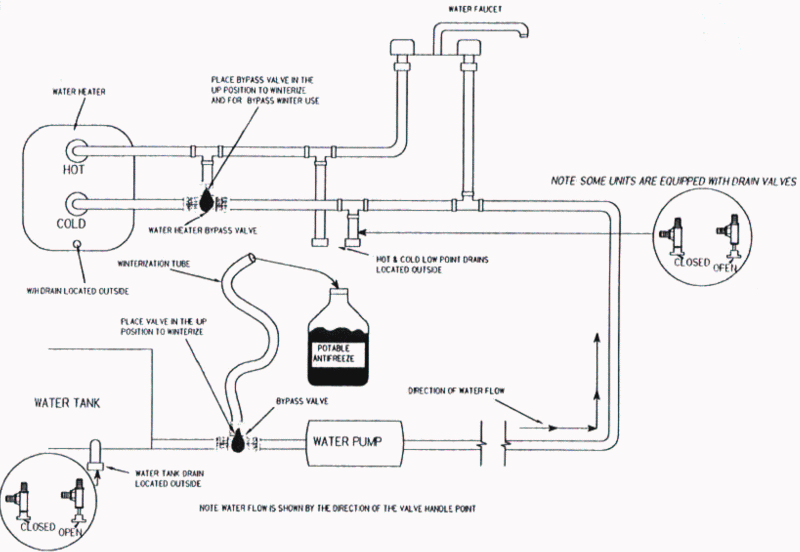RV Water System Winterization
-
Turn off the water pump and open a hot water faucet to bleed pressure from
the water system. Turn off the water heater control switches.
Make sure that both the propane and electrical controls for the water heater
are off.
-
Turn water heater bypass valve from the inline position as indicated in
the diagram. Note, some systems may have up to three valves as part
of the water heater bypass, one to block the cold water inlet, one to block
the hot water outlet, and one for the bypass. Set the valves as required
so that water flow bypasses the hot water heater tank. The reason
to bypass the hot water heater tank is to eliminate the need to fill it
with 6 – 10 gallons of potable antifreeze to flush the system.
-
Drain fresh water tank by removing the drain cap located outside or opening
drain valve.
-
Drain water heater by removing water heater drain plug. The drain
plug may also be the anode rod. Use caution as the water may be hot
if the water heater has been operational.
-
Drain all waterlines by turning on all water faucets in the unit and by
removing drain caps located on the exterior under unit or pulling open
the drain valves.
-
Empty (and flush as required) all gray and black waste tanks in the unit
and close the dump valves.
-
Reinstall drain caps or close drain valves on low point drains, fresh water
tank, and water heater.
-
Turn the bypass valve at the fresh water tank from the in-line position
to the bypass position as shown on the diagram and place the winterization
tube in a container of potable antifreeze.
-
Turn on the water pump. Starting at the water faucet closest to the
pump, open each hot and cold faucet (one at a time) until pure potable
antifreeze comes out, and then close faucet. Repeat for all faucets,
including galley, bathroom sink, toilet, interior shower, and exterior
shower. My experience has been that one gallon of potable antifreeze
will winterize a small RV, while a larger RV may take up to 2 gallons.
-
Pour potable antifreeze into all P-traps until you can see a level line
of potable antifreeze in the trap. This step may not be necessary
if sufficient potable antifreeze filled the traps when running the faucets.
-
When you plan to use the RV the next time, connect an outside water source
to the camper or by fill the fresh water tank and turn on the water pump.
Purge the potable antifreeze from the lines by running water through each
faucet and toilet until fresh water appears.

Printer Friendly PDF Version
Of This Page
Back to my RV Page

